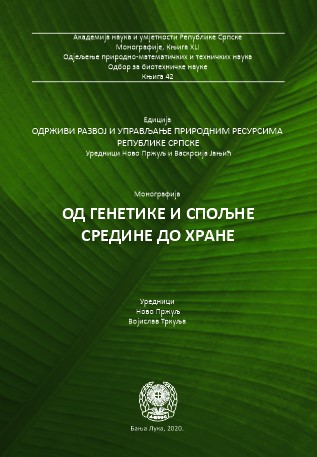Мaize hybrids for grain and silage in agro-ecological conditions of the Republic of Srpska
DOI:
https://doi.org/10.7251/EORU2001207MKeywords:
Maize, hybrid, yield, areas, breeding, conservation tillage systems, genetically modified plants, crop rotation, intercropsAbstract
Maize is used in human and animal nutrition, in industrial processing (nutritional products, pharmaceutical industry, alcohol industry, chemical industry, textile industry). Economical significance of maize is derived from its yield, namely its total production of grain maize, as well as silage. Today, together with potatoes and sugar cane, maize is used for production of bioethanol, a very important source of renewable energy. Maize is grown worldwide on surfaces of 192,05 million ha, on which around 1,108 billion tonnes of grain is produced. The largest producers of genetically modified corn in the world are USA, Brasil, Argentina, while in the EU GM corn is grown in Spain and Portugal. Maize is the most important field crop in the Republic of Srpska and is grown on 46.7 % of sown areas. In a ten-year period (2008-2017) the least growing area on which the maize was grown were in 2012 (120,901 ha), and the largest in 2008 (148,539 ha). The limiting factor in achieving high yield are meteoroidal conditions (high temperatures, draught or excessive rainfall) because of which average yield variation is from 2.7 to 5.3 t ha-1 . The biggest cereals and maize production in Republic of Srpska, the one of 1,657,556 tonnes, was achieved in 2016 which, compared to 2015 was an increase of 46%, or 520,000 tonnes, and was affected by a record breaking maize production of 1.178.423 tonnes. In organic corn production the sweet and popcorn are the most bred. The improvement in agricultural production mostly depends on perfecting the existing and developing the new and appropriate technical solutions. The accent is increased on protection of the environment, production of healthy and quality food and decrease in production expenses, and all of this can be achieved by applying the conservation treatment of soil. Growing corn in complete and regular crop rows, especially in which there are legume plants, can significantly affect the decrease in weediness and increase in grain yield. The corn is often grown in combined sowing with other plants, most often with soy, beans and fodder pumpkin. Maize breeding in past period created many hybrids, which enabled a permanent yield increase. The methods of conventional breeding are efficient but slow in creating a germplasm tolerant on existing range of climate conditions and are not suitable for rapid improvement of multiple stress tolerance. Molecular breeding enables increase in speed and efficiency of breeding. The only institution in Bosnia and Herzegovina which deals with breeding and creating new species and hybrids of grown plants, adapted to local agroecological conditions is the PI Agricultural Institute, Banja Luka. So far, the Institute created nine maize hybrids, the most significant being BL 43.
